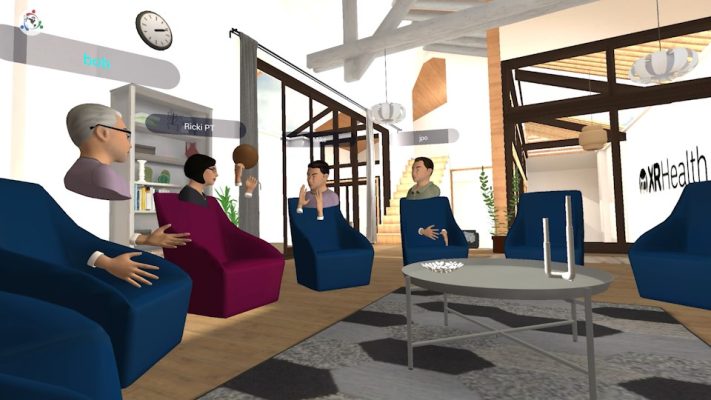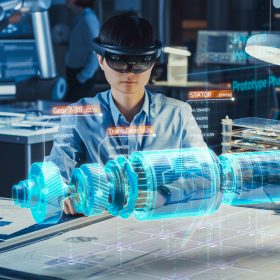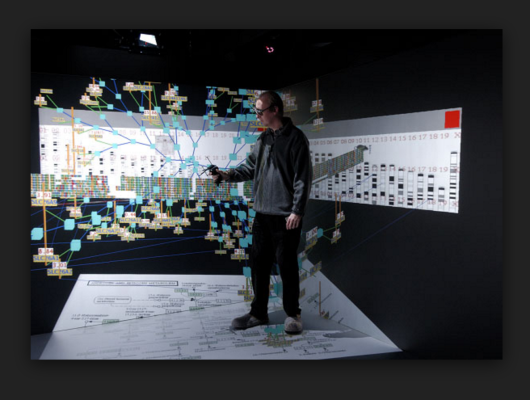What is Virtual Reality, Augmented Reality and What are the differences?
What is Virtual Reality?
Virtual reality is a computer-generated simulation where the user is in full immersion and can interact with the virtual environment. The user sees the virtual world through a VR headset, or a projection based device, and interacts with the objects.
In business, VR refers to a simulated experience that makes people see and feel unreal situations like real ones. Virtual reality has revolutionised the gaming and entertainment sectors by allowing users to immerse themselves in a highly simulated environment. It is also becoming a big player in the education sector, such as medical or military training. For example, in the medical sector they can create virtual hearts to train surgeons, and within the military there are virtual battle training areas.
I like to think of virtual reality as on tap. What I mean by this is that you are in a simulated experience where the world you are standing in is replaced with a virtual one. The reason I say on tap is because everything around and you are transported into a virtual world, like turning on a tap to release the water.
What is Augmented Reality?
Augmented reality augments your surroundings by adding digital elements to the real world. The value of augmented reality is the way it adds components of the of the digital world blended into a person’s perception of the real world through integration of sensations, which are perceived as natural parts of an environment.
Some examples of augmented reality which we already use are; trying on glasses virtually before buying them, using augmented reality to visualise what the glasses would look like on our own faces. Pokémon is one of the best cases of AR – seeing the animated characters in the real world. It is also being used in the healthcare, and education sectors.
Different to VR I like to think of augmented reality as on top, what I mean by this, is that you are still in the real world but with an addition to it. The reason I say on top is because you are enhancing the real world rather than immersing into a new one.
What is the difference between AR and VR?
VR technology is often confused with AR, they both are working towards the same goal – to make people experience emotions through virtual enhancement. But, they have differences.
VR and AR are similar but different – using my examples of the two, one is on tap, and one is on top, one enhances, and one replaces our real-life environment. They are two sides of the same coin.
- AR works by overlapping virtual objects in the real world whereas VR works by immersing you in a virtual environment.
- AR is placing virtual images into the normal settings of the user’s world with the help of technology whereas VR immerses the user into a virtual setting making them see and feel experiences that the company wants them to.
- AR users can control their presence in the real world, VR users are controlled by the system.
- VR in recent years has created a lot of buzz within the gaming sector, whereas AR is quietly breaking new ground in the enterprise sector.
- Both have great potential but are currently seeing the biggest growth within gaming, marketing, and e-commerce.
Virtual Reality and Augmented Reality in Data
Virtual Realty (VR) and Augmented Reality (AR) is everywhere, with a broad variety of applications across many industries, and the potential to revolutionise many others. The potential of VR and AR technology is endless and drives digital transformation. Lots of market research studies are projecting that VR and AR is forecasted to grow exponentially in the next few years. With this in mind, the questions people are starting to ask themselves are – what does this mean for me? What does this mean for my business? How will this change data and analytics? What are the differences?
Some of the biggest impacted sectors for VR and AR are going to be healthcare, engineering, real estate, retail, and education. The annual growth of the VR and AR market is increasing at around 70% based on figures from 2020-2023 (including the forecast for 2023), this is a quick and fast-growing digital transformation. The market is growing and will continue to grow due to increasing acceptance of VR and AR, and the responsiveness about the technology.
The main reason for this growth will be the development of using VR and AR with tablets, computers, and smartphones. Demand for 360 videos will continue to provide opportunities for content creators in this sector.
Employers who have already adopted VR and AR for training purposes are publishing the benefits of using this technology, and this is expected to grow within the coming years. Other companies have reported reduction in operational time as a result of using augmented reality headsets.
Covid seems to have shaped a new modern world for so many people and the reasons vastly differ, this has led to a gap in the market which VR and AR are already starting to fill. Being unable to leave our homes has allowed us to find other ways of connecting with each other.
What does this mean in Business?
VR/AR are widely used in the professional area. It is transforming today, and gives everyone the possibility to shape tomorrow. Thanks to VR/AR engineers, developers can now predict and solve issues before they happen.
More and more companies are adapting their workplace for VR collaboration, and that has become more necessary in today’s modern world, especially when many people are working from home. With complex projects, working remotely may not be possible with videoconferencing tools but by immersing people in a virtual world, it will open new possibilities.
What can you use VR/AR for?
- Create a prototype of a product.
- VR software optimises the conception phase of a project development by reducing the number of iterations. Optimising prototyping related costs. Enhancing the immersion.
- VR software optimises the conception phase of a project development by reducing the number of iterations. Optimising prototyping related costs. Enhancing the immersion.
- Run a project review in VR.
- Design reviews are necessary in many projects to get feedback and correct assumptions. It puts everyone on the same page. VR enables you to display and interact with the 3D data in scale 1:1.
- Collaboration
- Working remotely can prove to be a challenge when people are in different countries, but you need teamwork. VR offers the possibility to create shared digital workspaces where people can work on the same model.
- Visualise and interact with complex data.
- Sometimes, flat rendering data is not enough to fully visualise and interpret complex sets of data. Interactive virtual reality and augmented reality really helps you see and analyse phenomena that would otherwise be invisible to the naked eye.
- Train specific skills in a VR environment.
- Some training use cases involve scenarios that are too expensive, too dangerous, or impossible to do in the real world. Virtual reality training offers a safe space to develop both soft and hard skills – even when workers are not in the same location.
The future of Data Visualisation
Being part of the data world, it feels odd not to share data and visual ideas through static bar graphs, maps, and the like. We have the ability to deliver dynamic, interactive visuals that communicate insights faster, more effectively and in real time. I think it’s fair to say everyone can see, feel, and agree that pictures are invaluable and can have a huge impact. A picture says a thousands words right … Does this mean that the future of data visualisation sits with VR and AR?
The amount of data available to us and which we have coming in is growing considerably, we have so many new ways as well as the older ways of collecting data and even though it contains an endless stream of invaluable information it also provides the need of an infinite stream of maintenance and revision of data visualisations. Is this where VR and AR technologies come in?
The technology for VR and AR has a ton of potential in the data visualisation and analytics industry, imagine a virtual space or experience where you can manipulate, review, create, and transform data with 360 accuracies.
The way we visualise data will change forever; I remember seeing the movie Minority report and thinking we would never get to that level of interactivity with data but now that’s exactly what I imagine is coming around the corner. Having business presentations with multiple stakeholders located anywhere in the world being able to attend a virtual location. Think of a power BI report and how you could expand parts of a graph to show lower-level detail by expanding with your finger and thumb, or filter it by swiping away the groups you don’t want to see, or a map you can literally drop yourself into.
Working as a data engineer, I love data and find it exciting, however I know that not everyone feels the same. I have been in presentations where the audience have struggled to engage, or struggled to understand what is being portrayed with the data on a slide deck. VR and AR has the potential to change this and brings a new innovative playing field to the table. VR and AR technologies can offer data manipulation, processing, and review as an example it is possible to present data in a 3D canvas, wrapping around us visually to offer more advanced ways to interact with it.
There are already companies which are using Artificial Intelligence with VR working on experiences which they have called “immersive analytics”, which will give the viewers full control and allows them to explore the data to understand data sets. However, this is a new technology and currently most data visualisation experiences allow for smaller interactions, such as moving, reshaping, and viewing the data in new forms.
We all know the key phase of “the importance of data visualisations” and that we need correct and useful data visualisations for the key to understanding data. Bring able to have visual access to huge amounts of data will enable us to better understand not only data but also how it was collected. Humans have an incredible pattern recognition system which can be exploited further with the future of VR/AR. We have all heard people say “If I can’t picture it, I can’t understand it” – with the way VR and AR are changing the way we can visualise and picture data everyone should be able to understand it.
Virtual Reality with Big Data
The age we are living in is all about big data. We are collecting, ingesting, and transforming data at an astonishing rate but do we understand it? Or rather should the question be, are we getting the most out of our data? Big data is often unorganised and complicated, as data engineers we use tools at our disposal to display this data in an easy to read and understandable format, which then businesses often produce power BI reports using the traditional bar charts and pie graphs on 2D screens. According to Forbes, our eyes are limited to processing a mere 100 bytes of information a second on a traditional computer screen – so what happens when we need to process more information based on the amount of data available to us?
VR has the ability to propel users into 3D worlds and AR has the ability to enhance the real world, which is not only exciting but also proving extremely useful. Visualisation is crucial in understanding data and VR provides us with the ability to immerse into data in a more natural and intuitive way.
Big data will be immersive.
Large companies have already used VR and AR technologies to solve complex problems. I read an article about a formula 1 company which wanted to know why their tyres weren’t performing as well as expected and were able to use VR in order to gather the analytics and results from different choices and changes they could make – it was an incredible way of gathering and actioning data.
It seems interactivity is the next step to understanding data and immersion doesn’t mean much without the ability to handle data dynamically – we are all used to static data models behind understanding dynamic data but with VR and AR we can process data dynamically too. Imagine being able to reach out and touch the data – big data is going to be easier to comprehend and manipulate. With this way of presenting the data it will be easier for comprehension and will increase the amount of data we are able to process and therefore increase discovery.














Great advice Thank you!
I thoroughly enjoyed reading your blog post on the transformative power of AR/VR and how it is shaping the future of immersive experiences. The examples you provided beautifully illustrate the vast potential of this technology across various industries.
Overall, AR/VR has the power to transform our lives in numerous ways. It’s an exciting time to witness the advancements in this field and envision the possibilities that lie ahead. I’m eager to see how industries continue to embrace AR/VR to create innovative and immersive experiences that enhance entertainment, education, design, healthcare, and beyond. Thank you for shedding light on this fascinating topic!